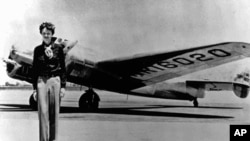On Monday, 75-years after she disappeared, a new search effort begins to try to solve one of aviation’s greatest mysteries – the fate of Amelia Earhart.
The legendary pilot’s plane vanished somewhere in the Pacific in 1937 while trying to complete a flight around the world. Now, new evidence indicates she and her navigator, Fred Noonan, may have spent their last days stranded on a remote island.
This week, on the 75th anniversary of Earhart’s disappearance, a ship carrying a crew from The International Group for Historic Aircraft Recovery (TIGHAR) along with its high-tech equipment leaves Honolulu, Hawaii for Nikumaroro in the western Pacific. It is estimated the journey will take at least eight days to reach the site where investigators believe the plane could have made its final landing.
Earhart and Noonan’s flight plan had them scheduled to land on Howland Island, but new research indicates the plane could have touched down instead on Gardner Island, now known as Nikumaroro.
“We’ve always wanted to do a search in the deep water off the west end of the island ever since we gathered the evidence that suggests, in quite a compelling fashion, that that’s where the airplane ended up,” said Ric Gillespie, executive director of TIGHAR. “But searching there is a whole lot more expensive than searching archeologically on land.”
The team will use high-tech submersibles to try to locate remnants of the aircraft. “We have an autonomous underwater vehicle that will have side scan sonar and cameras, and we’ll have a remote-operated vehicle that has very powerful lights and cameras and manipulator arms and sonar to check out any targets that we find in the autonomous vehicle,” said Gillespie.
TIGHAR was alerted to the possibility that the Earhart plane could have landed on Nikumaroro by two retired military officers who spent years investigating the mystery. One of them, 91-year-old Tom Gannon, was formerly a navigator with the U.S. Air Force. At the time of Earhart’s disappearance, he was 17 and taking flying lessons. He says the U.S. Navy search for Earhart was badly flawed.
“That was a real screw up on the part of the navy, they really screwed up real bad,” Gannon said. “There was a sunline that they [Earhart and Noonan] were flying on, and they [the navy] did not search along that sunline, that’s what I did.”
Gannon replotted the route along the sunline, which led to Nikumaroro. In addition, Gannon discovered an old film showing Earhart’s plane losing its receiving antenna as it made its final takeoff from Lae, New Guinea. “That was why, that was the main reason why she never was able to find the island [Howland] because she couldn’t receive a certain signal that she needed to from the island,” he said.
The 1937 naval search included a float plane that flew over Nikumaroro. “One of the pilots said the island showed signs of recent habitation and they never went back and looked!” said Gannon. “When I told Gillespie about this, that’s what got his attention.”
The legendary pilot’s plane vanished somewhere in the Pacific in 1937 while trying to complete a flight around the world. Now, new evidence indicates she and her navigator, Fred Noonan, may have spent their last days stranded on a remote island.
This week, on the 75th anniversary of Earhart’s disappearance, a ship carrying a crew from The International Group for Historic Aircraft Recovery (TIGHAR) along with its high-tech equipment leaves Honolulu, Hawaii for Nikumaroro in the western Pacific. It is estimated the journey will take at least eight days to reach the site where investigators believe the plane could have made its final landing.
Earhart and Noonan’s flight plan had them scheduled to land on Howland Island, but new research indicates the plane could have touched down instead on Gardner Island, now known as Nikumaroro.
“We’ve always wanted to do a search in the deep water off the west end of the island ever since we gathered the evidence that suggests, in quite a compelling fashion, that that’s where the airplane ended up,” said Ric Gillespie, executive director of TIGHAR. “But searching there is a whole lot more expensive than searching archeologically on land.”
The team will use high-tech submersibles to try to locate remnants of the aircraft. “We have an autonomous underwater vehicle that will have side scan sonar and cameras, and we’ll have a remote-operated vehicle that has very powerful lights and cameras and manipulator arms and sonar to check out any targets that we find in the autonomous vehicle,” said Gillespie.
TIGHAR was alerted to the possibility that the Earhart plane could have landed on Nikumaroro by two retired military officers who spent years investigating the mystery. One of them, 91-year-old Tom Gannon, was formerly a navigator with the U.S. Air Force. At the time of Earhart’s disappearance, he was 17 and taking flying lessons. He says the U.S. Navy search for Earhart was badly flawed.
“That was a real screw up on the part of the navy, they really screwed up real bad,” Gannon said. “There was a sunline that they [Earhart and Noonan] were flying on, and they [the navy] did not search along that sunline, that’s what I did.”
Gannon replotted the route along the sunline, which led to Nikumaroro. In addition, Gannon discovered an old film showing Earhart’s plane losing its receiving antenna as it made its final takeoff from Lae, New Guinea. “That was why, that was the main reason why she never was able to find the island [Howland] because she couldn’t receive a certain signal that she needed to from the island,” he said.
The 1937 naval search included a float plane that flew over Nikumaroro. “One of the pilots said the island showed signs of recent habitation and they never went back and looked!” said Gannon. “When I told Gillespie about this, that’s what got his attention.”







